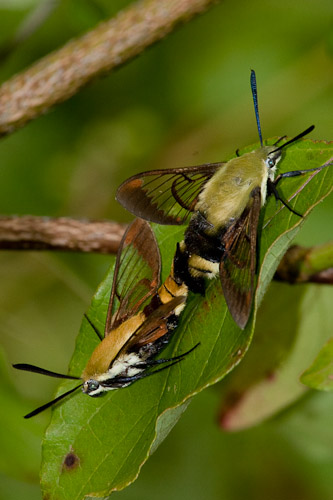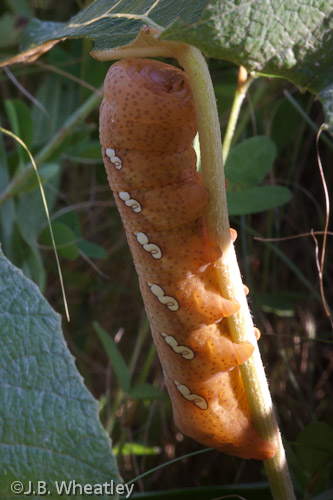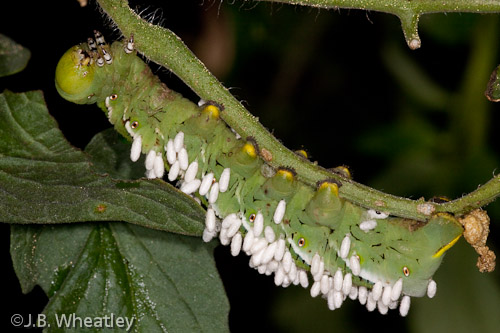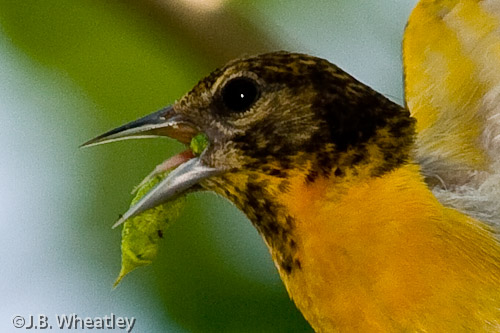This is the second part of a multi-part Note on Sphinx moths. This part deals primarily with caterpillars. Unlike the previous Note, this Note is free of wonky photography stuff.
Nature will take its course, and in the course of things, young will be produced.

Moths, like most insects, lay eggs. 1 Those eggs hatch and produce larvae, in the case of moths and butterflies, caterpillars.
Now for most folks, caterpillars are just caterpillars, and they pass without much notice or remark. However, Sphinx moth caterpillars are large, meaty looking critters, as big around as your thumb, which only the most distracted, if they noticed, would fail to remark.
That said, these caterpillars can be remarkably hard to find. At least for me, I spend a lot of time looking for them.
According to the website Butterflies and Moths of North America, we have fifty species of Sphinx moths in Pennsylvania. Of these, I have only seen about a dozen. Some, I have only seen as caterpillars, for example, the Achemon Sphinx (Eumorpha achemon), which feeds on grape and ampelopsis (in the grape family, it looks like a grape—it just isn’t).
Another adult that I have yet to see is the Virginia Creeper Sphinx, aka Hog Sphinx (Darapsa myron), but I have seen the caterpillar—on the same grape vine on the same day as I found the Achemon Sphinx. As you can guess, they eat Virginia Creeper, as well as grape and ampelopsis.
Closely related to the Achemon Sphinx is the Pandorus Sphinx (Eumorpha pandorus), another eater of grape and its relatives. This is a striking critter. Note how the big white spots are slightly different from the double white spots of the Achemon caterpillar. I had to have this pointed out to me, as I originally had misidentified the Achemon as a Pandorus. Both tend to turn brownish in their later instars—I suspect this has to do with the fact that they will soon leave the vines and go walking about looking for a place to pupate underground. Bright green caterpillars walking on brown leaves get noticed—getting noticed is a good way of getting eaten.
The most commonly observed Sphinx moth caterpillar is the Carolina Sphinx or Tobacco Hornworm (Manduca sexta).

Now, where tobacco is a major crop, these caterpillars and the closely related Five-spotted Hawkmoth caterpillars, indiscriminately referred to as “tobacco worms,” are a major pest. Growing up in Maryland, and having spent much of my life south of the Mason Dixon line, I have met plenty of older gents who would regale me with stories of their childhood hand-picking tobacco worms off the Burley, dusting the leaves with Paris Green, or spraying lead arsenate on the entire plants. 2 Late in the day, they would troop into the fields and put a spoonful of strychnine in the trumpets of Jimson Weed (Datura stramonium), to kill the adult moths as they visited the flowers. Imagine sending your pre-teen out in the fields with a spoon and a jar of strychnine—what could go wrong there? All this without any protective equipment.
However, for those of who live outside of tobacco country, this caterpillar is primarily a pest of tomatoes, and indeed, that is where I often find them, on my tomatoes. This is not, however the Tomato Hornworm, or Five-spotted Hawkmoth (Manduca quinquemacula). We have those too, but I have never seen the caterpillar.
David Wagner prefers that Tobacco Hornworms be called the Carolina Sphinx, and seeing as his excellent Caterpillars of Eastern North America is one of the finest field guides ever writer—no matter the subject. I will readily adopt his preference.
My cleomes attract sphinx moths, including the Carolina Sphinx, and I have several cleomes planted right alongside of my ‘mater patch—a tactical error. Now I love my tomatoes, but my sympathies here lie with the moths, for any larvae that hatches in my garden faces a short, grim life and a doleful death.

Every year I get a couple of Carolina Sphinx moth caterpillars on my tomatoes. And every year those caterpillars get attacked by a Braconid Wasp called Cotesia [or Apanteles] congregata. This is gruesome; to quote David Wagner:
“[The] wasp …lays dozens of eggs within each larva. When fully mature each wasp larva tunnels to the outside of the caterpillar’s body and spins a whitish cocoon. The host caterpillar is doomed, consigned to a slow death that may not follow for weeks.” 3
It’s rough out there, folks.
And the little Braconids are not the only parasite out there. I sent a copy of the Hog Sphinx photo to a correspondent, and she noticed a small wasp walking around on the caterpillar. Now her initial reaction was “I’d probably have knocked it off,” but she is ever gracious, so she complimented me for leaving the little parasitic wasp on the caterpillar as a shot of “what actually happens in nature.”
Love to take credit, but I thought it was a speck of dirt until I blew the picture up on my computer screen.
Now bugs like this little wasp are almost impossible to identify without picking them apart under a dissecting microscope. Not something I want to do and, besides, I didn’t have the bug at hand. However, I gamely picked my way through Arnett’s American Insects, and I’m not certain, but I think this little dude may be a parasite–of parasites. There are some little Chalcids that parasitize wasps that parasitize caterpillars, and this looks, at least superficially, like it could be one. I have sent the photo to an expert—watch this space.
Beyond parasites, of course, there are predators. As I noted earlier, this is a large chunk of protein, and birds and small mammals take a toll. One spring a few years back I saw a young Baltimore Oriole throwing a conniption fit about ten feet up in a sycamore tree. I took several photos, but, once again, I didn’t really know what the fuss was about until I saw the photos on my monitor.
Apparently, the youngster had bitten off more than he could chew. Actually, he had stuck his bony tongue through the caterpillar, and could neither swallow nor spit: a bad place to be. I’m happy to say that the Oriole survived—pretty sure the caterpillar didn’t make it.

ou might be thinking that, once they make it to the pupal stage, they are fairly safe. Well, I’m pretty sure that shrews and mice take a pretty good toll, but there is worse—much worse.
So, you’ve escaped the parasites, dodged the birds and the mice and the shrews, turned brown and made your way to a nice spot of loam, all good—except somewhere along the way, you stepped on a spore—a microscopic spore of the genus Cordyceps, in this case Cordyceps militaris. And while you are supposed to be going through the astonishing process that changes a sluggish caterpillar into one of nature’s master aviators, instead, you are being consumed alive by a fungus.
Over time, you will become just a big chalky mess inside the pupa, and come summer, a little orange mushroom will sprout, all covered with sticky sweet stuff that will draw gnats and other small critters. And when those small critters fly away and land somewhere, they will deposit spores wherever they land—just waiting for next year’s caterpillars.
Nevertheless, despite the odds, some will make it to adulthood, and most of those will become masters of night flight—stay tuned.
- Aphids are viviparous, that is, they bear their young alive. They are also capable of reproduction without sex (parthenogenesis)—whoopee.
- Setting aside its poisonous nature, Paris Green, a compound of copper and arsenic, was just a terrific product. It was first used to kill rats in the Paris sewers. Later it was favored by housewives to kill cockroaches. It killed the roaches, and from time to time, it killed the housewives—and their families and friends. It was also the base pigment for the artists’ color Emerald Green, which was a favorite of Cezanne, who developed severe diabetes, (symptomatic of arsenic poisoning), Monet, who went blind (symptomatic of arsenic poisoning), and van Gogh—who became a bit of a nut (symptomatic of arsenic poisoning). I suspect it added a bit of a kick to healthful effect of cigarettes as well.
- David L. Wagner, Caterpillars of Eastern North America (Princeton University Press, Princeton, NJ, 2005). p. 248
